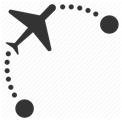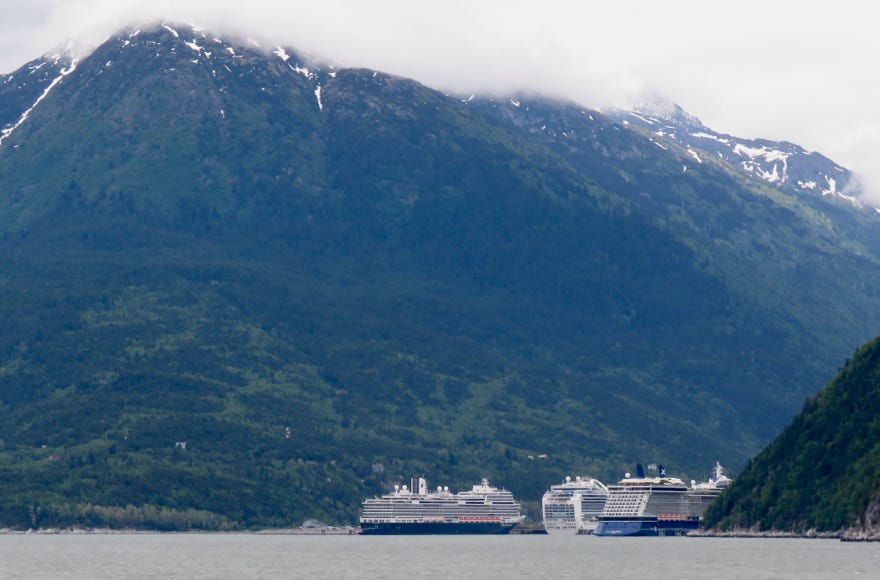Arrival and Skagway



June 12-13, 2022
This was our first trip on an airplanes since we flew home from Central America on March 17, 2020. Lots happened after that, and we chose to stick to road trips. We are now brave enough to fly, at least within the US. So we left Oakland Sunday afternoon and flew to Seattle, where we stayed the night in order to make an early connection on Monday to Juneau. The airline kept changing its schedules, and flying on a single day had a very short/risky connection time. Not having flown in two years, we were surprised by the crowds at the airports.
This will be our second trip to Alaska. We previously visited Denali, Anchorage, South Central Alaska and the Kenai peninsula, a trip made by car. This trip will rely on boats and planes in addition to cars, and will be located solely in the southeast, aka Alaska Panhandle.
Monday, June 13, 2022
We flew from Seattle to Juneau and arrived at lunch time. We picked up a rental car and drove to the ferry terminal to get the lay of the land, and then went to a supermarket (to purchase tomorrow’s breakfast). We checked in to our motel, which was close to the airport. After a bit of time, the rain lessened, and we drove to downtown Juneau to see the sites and find where things were for our later return. We drove there through the Mendenhall Wetlands and saw more than a dozen bald eagles. We would take this same route several times over the course of the trip and there were always many eagles.
After that, we settled into our motel with take-out and watched the Warriors in Game 5 of the NBA championship.

Here’s a map of the flight path.
Tuesday, June 14, 2022
We rose at 4 AM and drove about fifteen minutes to the Alaska Marine Highway ferry terminal at Auke Bay. They instruct you to get there two hours before the ferry departure, which was 7 a.m. That results in some waiting around. Prior to our trip, we called and asked if overnight parking was permitted and the nice man told us to ignore the signs saying it was not. He said that so long as it was just a few days “you should be fine.” Well we trusted he was right. We chose to do this rather than taking the car on the ferry because of concerns about the possibility of ferry cancellations. Since COVID, staffing issues sometimes resulted in sailings being cancelled. If we didn’t have our rental car, we always had the option of flying back to Juneau if the return ferry was cancelled. As it turned out, all went fine.
So we left our rental car in the parking lot at Auke Bay and boarded an Alaska State Ferry (as foot passengers). We sailed for Skagway, with a stop at Haines. The trip took a bit over six hours. The views were good but not spectacular because of many low clouds. At least it had stopped raining. The ship was the “Le Conte” which we pronounced “le cont” and the locals pronounced “le cont-ee”. We went to Berkeley and know how the famous (infamous?) professor Le Conte pronounced it. We found a comfortable window seat (with power!) and had lunch from the café on board.

Left, view from ferry, and below, approaching Skagway


We got off the ferry in Skagway, which has a year round population of around 1,200. It is a popular tourist center, attracting 1,000,000 visitors a year, the vast majority coming on cruise ships, meaning there were very few hotels. There were at least four cruise ships here every day during our visit.
When we arrived at Skagway, we picked up a second rental car that was waiting for us in the terminal parking lot. We then drove less than a half mile to the Klondike Gold Rush National Monument Visitor’s Center/Museum. Although there were long Tlinget settlements in the area, and a few European settlers who arrived around 1887, it was not until the Yukon gold rush of 1986-1897 that Skagway began to attract larger numbers of settlers, it being a gateway to the quicker routes to the goldfields. The Museum has informative displays in historic buildings about the gold rush and the building of the railroad up into the Yukon. One thing that was amazing was that the prospectors were required (by the Canadian government) to bring enough food to last a year (to prevent mass starvation). This alone amounted to over 1,000 pounds. So getting to the Goldfields in Dawson took dedication and stamina. Not to mention that the gold rush pretty much ended by 1899. But apparently, 100,000 people tried their hands at prospecting during that short window. The Klondike National Historical Park has many historic places to visit both in and around Skagway, as well as in Seattle.
After seeing the museum, we then walked around the historic center of Skagway, which goes back in time to the late 19th century. There were many cruise passengers in town (and a few too many shops catering to them). We saw a number of historic buildings and noted that the main street, Broadway, has pedestrian boardwalks. We visited an old Victorian house that was built by one of the town’s early residents (the Moore Homestead). After that, we checked into the only true hotel in town.
We then drove out of town a mile or two to the Gold Rush era cemetery and then up behind the cemetery, we walked to Lower Reid Falls. It had a lot of water.


Lower Reid Falls to the right and old buildings in Skagway, above.

We noticed that once the cruise passengers started going back to their ships in the late afternoon, it got really quiet. There were no crowds in the evenings, see right.
June 15, 2022
It was clear today when we woke up, and actually was supposed to be quite warm.
We were picked up at our hotel early in the morning and taken to a passenger only ferry that was to take us to Haines, where we were going to ride in a jet boat. After we left the dock on the ferry, the skipper said the engine wasn’t working properly and we returned to the Skagway dock. This caused a lot of trouble for us and the other passengers, and unfortunately all of us had our day trips cancelled.
We returned to our hotel, and decided to go on a nearby hike to Lower Dewey Lake. The trail climbed a lot above the town for about two and a half miles through a lush green forest. From the trail, we had a fine view of the town of Skagway, next photo. Lower Dewey Lake is below.


Returning to town, we had lunch from a food truck, and afterwards drove our rental car on the Klondike Highway towards Canada. We saw a number of gorges and waterfalls, and turned around at the White Pass Summit (about 14 miles), which is almost to Canada. Driving back to Skagway, we went through US Customs, where we stated we had not gone into Canada, and (despite the unfriendly demeanor of the CPB agent) were allowed to continue back to town.

Skagway River at White Pass

Photo to left from the road.
When we got back to Skagway, we parked near the small airport and walked across a pedestrian bridge across a river and on to Yakutania Point, which has a beautiful view back down the fjord. Photo below.

June 16, 2022
Today we had tickets to ride the White Pass and Yukon Railroad to White Pass and back.
Because of COVID, journeys on the train into Canada were not running this year. The journey took about three hours and we did not leave the train. The scenery was beautiful, and the railroad is an engineering marvel. It was built to be an alternative to the Chilkoot trail or the toll road over the White Pass, two ways to get to the Yukon for the gold rush. The train construction started in spring of 1898 and employed 2,000 workers. The first train reached Bennett, in British Columbia, by July of 1899, and construction to Carcross was completed in July 1900, a period of just over two years. What an amazing feat (looking at you, BART). Of course, by then the gold rush was over, and the train has mostly been a tourist train for over a hundred years (with a short period where it did not run).
We enjoyed the train ride, and saw different views than from the road. The lakes were still frozen when we got to White Pass. Each train car had an observation area at the ends where you could step outside to take photos. It was an enjoyable trip and we were glad to have both driven and ridden the train on the route.

Our train to the
right and below
several photos
from the journey. The last one is
the frozen lake
at the pass.



After lunch, we went to the Skagway City Museum. In the late afternoon, we took a guided tour to the former town of Dyea (the “a” is silent). Dyea was actually a bigger settlement than Skagway at the beginning of the Gold Rush, with its population peaking in 1898. We heard figures from 3,500 to 40,000, but we think the most reliable information is it reached 5,000-10,000. Everyone agrees it had “48 hotels, 47 restaurants, 39 saloons and one church”. But on April 3, 1898, there was a massive snow slide, known as the “Palm Sunday Avalanche,” on the Chilkoot Trail which killed over 70 people and led to Dyea’s decline. It is now a ghost town, and except for the cemetery, a few pieces of wood and the faint outline of the former street grid, you could not tell anyone ever lived there.
The tour was interesting, we saw an estuary, nice wildflowers, a portion of the Chilkoot Trail, the former townsite and the Slide Cemetery, where the victims of the avalanche of 1898 are buried. Dyea had several thousand or more residents at its gold rush peak, but now almost nothing of the town remains. Here are some photos from the tour:





The flower to the left is a chocolate lily. Above are views back toward Skagway from Dyea. The grave marker is for a poor soul who survived the avalanche… for a few weeks.
We got back to town at about 7 p.m. and were able to more or less catch most of the second half of the sixth (and final) game of the NBA championship, which the Warriors won.
Tomorrow, we take the same ferry back to Juneau.
